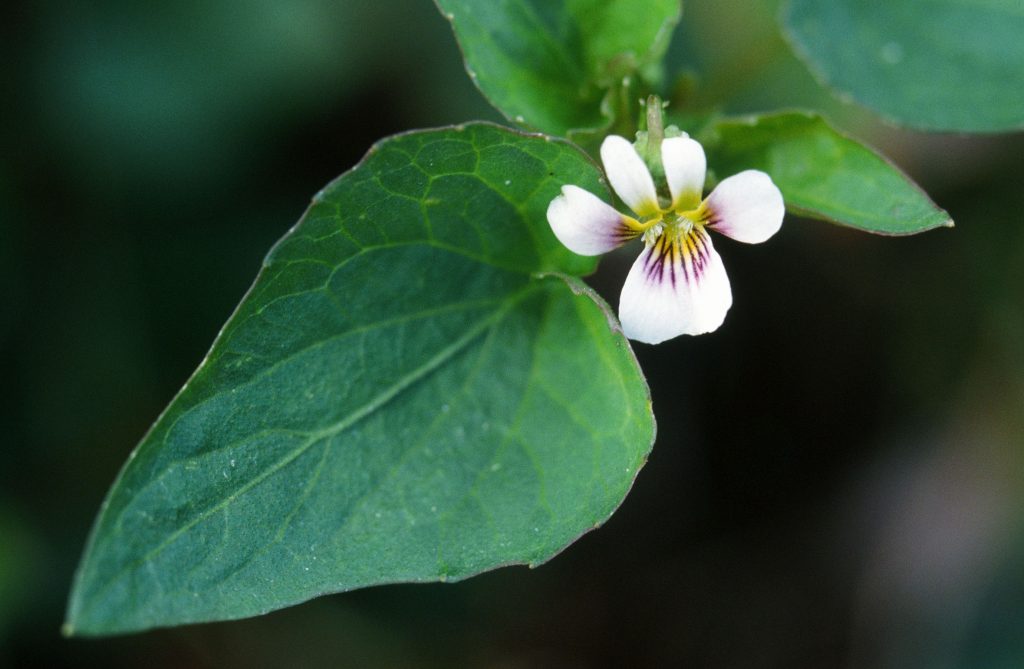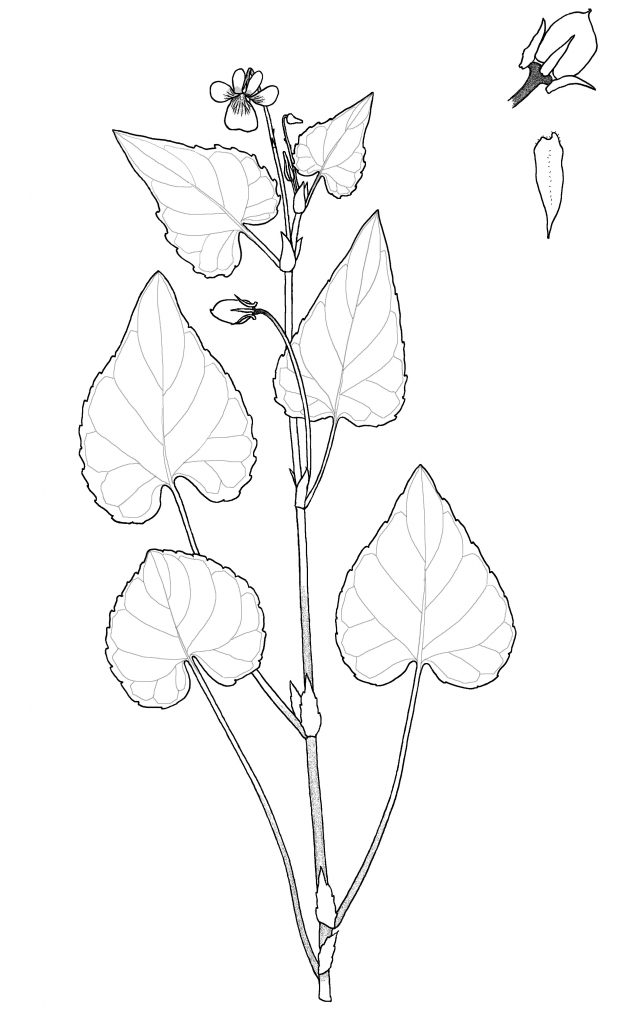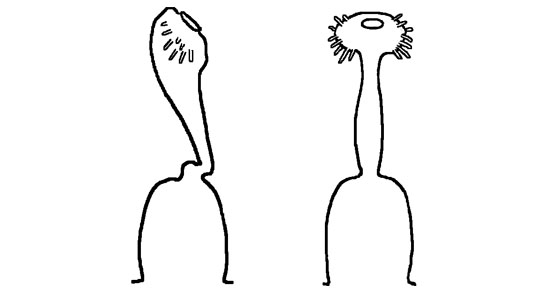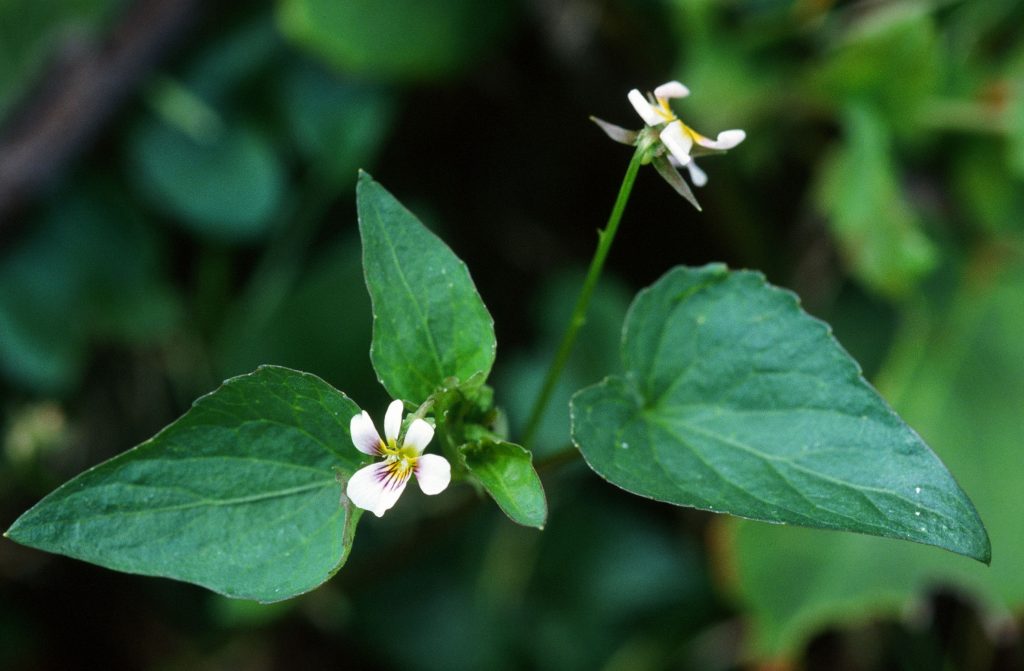Viola scopulorum
Description. Illustrations: 2 photographs of Viola scopulorum and 2 drawings.
Viola scopulorum (Boulder Co, CO. May 1995)
A diploid species of subsection Canadenses, Viola scopulorum is tall, with rigid vertical stems, similar in height and general habit to V. canadensis. However the leaves, petioles and flowers are smaller, basal leaves are about half the size. The plants appear and flower earlier and are in seed by the time V. canadensis flowers appear. These two species sometimes grow in close proximity, V. scopulorum in less shaded positions, but do not seem to hybridize as there are no intermediate forms. This species is confined to the foothills on the eastern slope of the Rocky Mountains of Colorado and New Mexico.
At flowering its plants are 10 -14 cm high, by mid-summer 45 cm high, with up to five stiff stems arising from one vertical rhizome. Cauline leaves are distributed evenly along the whole stem. They stand tall and narrow in more open locations, whereas V. canadensis may form dense colonies in the shade. Stems, pedicels and petioles are glabrous or with extremely minutely pubescent; stems purple toward the base. Similar to V. canadensis, V. scopulorum produces only basal leaves in its first season but these can be identified by their characteristic smaller shape and their brighter green color.

At flowering, petiole length of the basal leaf is 6 cm, mid-summer up to 17 cm; petiole of the lowest cauline leaf 5 cm, upper cauline petiole 1 cm or less. Basal stipules are thin, purple; lower stem stipules scarious, up to 1 cm long, upper stem stipules green, 0.4-0.5 cm; all lanceolate with a few marginal teeth.
The leaves are dark green, very finely puberulent to pubescent on both surfaces and veins and sparsely on the margins. Usually one basal leaf per stem is produced, leaves wide cordate, 2.7 – 3.5 cm long x 2.8 – 3.7 cm wide, enlarging to 5.5 cm in mid-summer. Stem leaves are long-ovate, 4.5 cm long x 3.2 cm wide at flowering, to 6.0 cm long x 4.5 cm wide in mid-summer, base cordate, apex attenuate, upper third to half of leaf with an entire margin, the lower part dentate. Upper cauline leaves are tinged with purple on lower surface.
Very narrow bracteoles are above the middle of the pedicel, 1-2 mm long. becoming scarious. The small flowers are more similar to those of V. lithion than V. canadensis, 1.0 cm x 1.0 cm and lacking perfume. Flowers are above the leaves, their peduncles from the leaf axils. White to mauve-pink petals are the same color on the outside of the petals; the yellow color at the center of all petals is surrounded on the lateral and keel petals by a flush of purple, and there are purple guidelines on lowest petal. Upper two petals short and narrow, the lowest petal is twice as wide as lateral petals. Hairs on the inside of the lateral petals are hairs relatively long and distinctly clavate, colorless. The spur pale green, less than 1 mm, barely exceeding the sepal appendages. The stigmatic head has hair-like projections on the sides and a large stigmatic opening, but no lower lip. Calyx green, 4-6 mm long; sepals and appendages narrow and separated, sepals glabrous or shortly ciliate on margin and along midline, appendages not close to the peduncle.

Seed pod green to light purple, 0.7 cm; peduncle green, dark purple at the top near the calyx. Seeds dark brown 1.5 x 0.8 mm. No cleistogenes.
Viola scopulorum grows in open grassland, in part shade between rocks and small conifers and on the edge of, and in, open woods, in drier places than V. canadensis.
Range: Colorado and New Mexico, in the eastern foothill canyons of the Rocky Mountain Range to the southern end of the Sangre de Cristo Mountains, on the narrow band of Pennsylvanian red sandstone. 1800-2500 m (6,000-8,000 feet). This foothills zone is characterized by shrubs, dominated by scrub oak (Quercus gambelii), mountain mahogany (Cerocarpus montanus), three-leaf sumac (Rhus aromatica trilobata), and common juniper (Juniperus communis alpina). Trees of Ponderosa pines (Pinus ponderosa scopulorum), Douglas firs (Pseudotsuga menziesii), blue spruces (Picea pungens), and scattered aspens (Populus tremuloides) grow as open woods.
Nomenclature and Taxonomy
Viola scopulorum (A. Gray) Greene. Pittonia 5: 27. 1902.
(syn. Viola canadensis var. scopulorum Gray, A. Gray Bot. Gaz. 11: 291. 1886.
Section Chamaemelanium Becker, subsection Canadenses (Marcussen, 2011).
A diploid species, with chromosome number: 2N=2x=12 where the base chromosome number x=6, compared to the tetraploid species V. canadensis (2n=24).
‘Scopulorum’ means ‘of the pointed rocks, cliffs, crags’.

